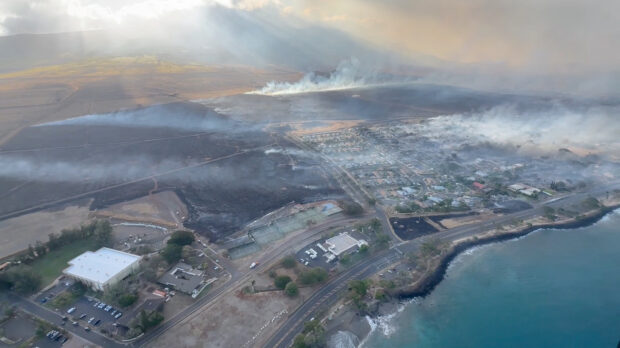Maui fires death toll rises to 53, governor says; over 1,000 structures burned

(UPDATED 8:19 a.m., August 11, 2023, to reflect the latest death toll)
LAHAINA, Hawaii — Hawaii Gov. Josh Green said Thursday that 53 people were killed in the devastating Maui wildfires, and the death toll will likely continue to rise.
Search and rescue operations were continuing, Green said, and officials expect it will become the state’s deadliest natural disaster since a 1961 tsunami killed 61 people on the Big Island.
More than 1,000 structures were destroyed by fires that are still burning in Lahaina and surrounding areas.
“Lahaina, with a few rare exceptions, has been burned down,” the governor told The Associated Press.
The wildfire that swept through the resort town of Lahaina on Hawaii’s Maui island left behind smoldering ruins and forced thousands to flee the onetime capital of the Hawaiian Kingdom.
Video footage showed neighborhoods and businesses razed and vehicles burned to a crisp across the western side of the US island as the wildfires cut off most roads out of Lahaina. The town is one of Maui’s prime attractions, drawing 2 million tourists to the island each year, or about 80 percent of the island’s visitors.
The wildfires took most of Lahaina’s residents and visitors by surprise when they broke out late on Tuesday, forcing some to run for their lives and jump into the ocean to escape the fast-moving inferno.
READ: Biden declares Hawaii fires a ‘major’ disaster, unblocks federal aid
Nicoangelo Knickerbocker, a 21-year-old resident of Lahaina, had just awoken from a nap on Tuesday evening when he saw the fires burning through his hometown. His mother and sister fled, while he and some friends went to neighbors’ houses, helping people pack belongings and trying futilely to stem the flames with garden hoses.
“It was so hot all around me, I felt like my shirt was about to catch on fire,” he said from one of the four emergency shelters opened on the island. The shelters are housing more than 2,100 people, Hawaii News Now said.
Knickerbocker heard cars and a gas station explode, and soon after fled the town with his father, bringing with them only the clothes they were wearing and the family dog. “It sounded like a war was going on,” he said.
At least 20 people suffered serious burns, and several were airlifted to Oahu for medical treatment, while more than 11,000 visitors were evacuated from Maui, Ed Sniffen of the Hawaii Department of Transportation said late on Wednesday.
Though at least 16 roads were closed, the airport was operating fully, he said.
READ: Explainer: How did the Hawaii wildfires start? What to know about the Maui and Big Island blazes
Most of the roughly 400 evacuees at the War Memorial shelter on Thursday morning had arrived in shock, with an “empty look,” said Dr. Gerald Tariao Montano, a pediatrician who volunteered to work a six-hour shift on Wednesday night.
“Some haven’t fully grasped that they lost everything,” he said. He pleaded for donations of clothes, supplies, food, baby formula and diapers.
Governor Green said Hawaii had not seen such widespread disaster and death since 1960, one year after it became a US state, when a tsunami killed 61 people.
READ: Wildfire-ravaged Maui has thousands of Filipino residents
The fate of some of Lahaina’s cultural treasures remains unclear. The historic 60-foot(18-meter)-tall banyan tree marking the spot where Hawaiian King Kamehameha III’s 19th-century palace stood was still standing, though some of its boughs appeared charred, according to a Reuters witness.
Some 271 structures were damaged or destroyed, the Honolulu Star-Advertiser reported, citing official reports from flyovers conducted by the US Civil Air Patrol and the Maui Fire Department.
“We will need to rebuild the entirety of Lahaina, I believe,” Green told KHON 2, a local Fox affiliate.
READ: People in Hawaii flee into ocean to escape wildfires
Wiping away tears, he said he expected the next few days to be “incredibly traumatizing” as firefighters discovered more victims.
US President Joe Biden approved a disaster declaration for Hawaii, allowing affected individuals and business owners to apply for federal housing and economic recovery grants, the White House said in a statement.
The cause of the Maui wildfires has yet to be determined, officials said, but the National Weather Service said dry vegetation, strong winds, and low humidity fueled them.
Wildfires occur every year in Hawaii, according to Thomas Smith, an environmental geography professor at the London School of Economics and Political Science, but this year’s fires are burning faster and bigger than usual.
Three separate blazes
Firefighters were battling three separate blazes on the island, officials said late on Wednesday night, without providing details. Fires also destroyed parts of Kula, a residential area in the inland Upcountry region, and Kihei in South Maui.
READ: It’s very windy and dry in Hawaii. Strong gusts complicate wildfires and prompt evacuations
Scenes of fiery devastation have become all too familiar elsewhere in the world this summer. Wildfires, often caused by record-setting heat, forced the evacuation of tens of thousands of people in Greece, Spain, Portugal, and other parts of Europe. In western Canada, a series of unusually severe fires sent clouds of smoke over vast swaths of the US, polluting the air.
Human-caused climate change, driven by fossil fuel use, is increasing the frequency and intensity of such extreme weather events, scientists say, having long warned that countries must slash emissions to prevent climate catastrophe.
The Maui blazes began on Tuesday night as powerful winds from Hurricane Dora, hundreds of miles to the southwest, fanned the flames. By Thursday, the strong winds had largely abated.
About 11,000 homes and businesses were without power on Maui, which has a year-round population of 165,000, according to the tracking service PowerOutage.US.